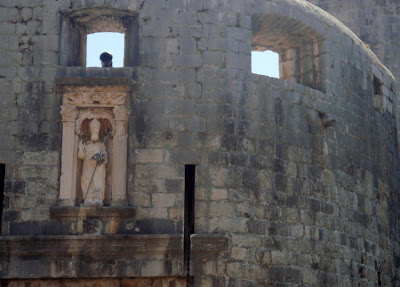Dubrovnik, Croatia
Eastern Mediterranean
Above is the Franjo Tudman Bridge near the Port of Gruz where we were docked. The bridge was designed in 1989 but construction was stopped during the 1991 Croatian War of Independence.
This photo does not do justice to the beauty of the flowering bushes and trailing flowers everywhere. Simply stunning. The mountains further inland protect the coastline from chilly inland temperatures. See the palm trees?
This photo does not do justice to the beauty of the flowering bushes and trailing flowers everywhere. Simply stunning. The mountains further inland protect the coastline from chilly inland temperatures. See the palm trees?
Dubrovnik is now a quiet, picturesque tourist stop for many cruise liners. There is little evidence of the shelling Dubrovnik took from the Serbs during the seige. Incidently, a pretty good idea of the war can be seen in the movie "Harrison's Flowers".
Dubrovnik is known as the "Walled City" as the old city has 1.24 miles of walls consisting of turrets and towers intended to protect the city. A major tourist attraction is to walk the wall around the city. Christine did not want to walk that far so we walked around in the old city probably logging twice that distance.
Above is Fort Bokar built to protect the city while the city walls were being constructed, and it was the key point in the defense of Pile Gate which leads into the old city.
The St. Lawrence Fortress is also located outside of the city walls. Above one of the drawbridges that leads to the fort is an inscription that is still so relevant today: "Non Bene Pro Toto Libertas Venditur Auro" –"Freedom is not to be sold for all the treasures in the world."
The Nymph and Satyr statue is just outside the Pile Gate.
Pile Gate (above) is the grand entrance into Dubrovnik's Old Town. The statue is St. Blaise, the city's patron saint.
Bell towers are scattered throughout the old city.
This is the entrance to a nice museum that we visited. Sorry, no pictures inside were allowed.
Typical narrow street (walkway?) predominant throughout the old city.
Church of St. Blaise. St Blaise is the city's patron saint as it is chronicled that St. Blaise appeared in a vision to a canon of St. Stephen's Cathedral warning him of the city's impending attack by the Venetians, thereby saving the city.
This is the Jesuit Church of St. Ignatius.
It was built between 1667 and 1725 and was modeled on the mother church Gesu located in the Piazza del Gesu, Rome.
View of Dubrovnik from near the Jesuit Church.
No, we weren't visiting on a Monday. In the old city, one practices old (efficient) ways, right?
Contrast the old city with the newer part of town. I prefer the old.






















This is amazing!
ReplyDelete